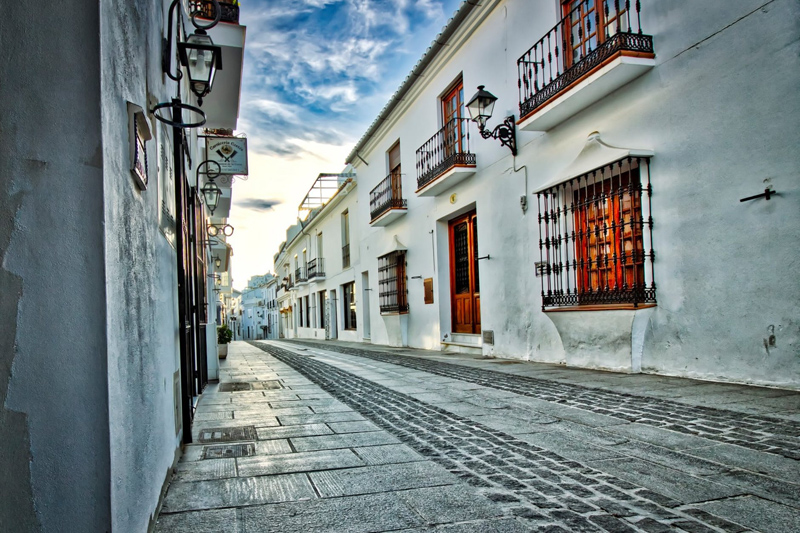Spanish Definite Articles

Spanish Definite articles correspond to the English article the.
THE = EL, LA, LOS, LAS
But why these four forms? First of all, take a look at the following table:
MASCULINE / SINGULAR: EL
MASCULINE / PLURAL: LOS
FEMININE / SINGULAR: LA
FEMININE / PLURAL: LAS
Let’s analyze the first point: The Genre. Spanish nouns can be either masculine or feminine. So it’s corresponding article will always be in accordance to it (to the genre of the noun), For example:
“La perra es blanca” (The “female dog” is white)
In this case, “perra” is a feminine singular noun, so the article must also be feminine. And now, an example with a masculine noun:
“El perro es negro” (The dog is black)
Here, “perro” is a masculine singular noun, so the definitive article will be “el”.
And now, we’ll take those same examples and we’ll build their plural forms. So the first sentence, in plural, is:
“Las perras son blancas” (The “female dogs” are white)
As you may have noticed, there is another word that has also changed: (“blanca” --> “blancas). And that’s another difference between English and Spanish languages we’ll study soon: Spanish adjectives must also correspond in genre and number with the noun (substantive) they qualify. So, if we now change the masculine sentence into its plural form:
“Los perros son negros” (The dogs are black)
Both, the article and the adjective must also take the gender and number of the noun they’re with.
The table below shows the examples we have used, according to the classification given for the Spanish Definite articles, so that you can have a clear idea about them:
MASCULINE / SINGULAR: “El perro es negro”(The dog is black)
MASCULINE / PLURAL: Los perros son negros”(The dogs are black)
FEMININE / SINGULAR: “La perra es blanca” (The “female dog” is white)
FEMININE / SINGULAR: “Las perras son blancas”(The “female dogs” are white)
Finally, I suppose your next question is: But how do I know if a Spanish noun is masculine of feminine? This is a very, very common question among Spanish language students.
And here’s my advice: If you have an English – Spanish / Spanish English dictionary, just look for that word. Close to it you’ll find either “mn” (masculine noun) or “fn” (feminine noun). In case you don’t have that kind of dictionary at home, you can always go to Wordreference, an online dictionary, very helpful from my point of view. Once at that website, just type, i.e., the word “gato” on the “Spanish to English” box and click on “GO”; you’ll get the following: “gato/a” which means that this noun has two forms: gato / gata. The first one is its masculine form and the second one the feminine one. Easy, isn’t it? ;-)
Ok, these are the basics on Spanish Definite articles. Sure you have any question, comment or doubt. If do, feel free to e-mail me or just post a message at the Forum. I’ll answer you as soon as possible.
¡Y esto es todo! (And that’s all!)
¡Que tenga un buen día! (Have a nice day!)
¡Adiós! (Goodbye!)
Recommended material:
You can find below some materials / web pages that, from my point of view, can be useful and interesting:
THE = EL, LA, LOS, LAS
But why these four forms? First of all, take a look at the following table:
MASCULINE / SINGULAR: EL
MASCULINE / PLURAL: LOS
FEMININE / SINGULAR: LA
FEMININE / PLURAL: LAS
Let’s analyze the first point: The Genre. Spanish nouns can be either masculine or feminine. So it’s corresponding article will always be in accordance to it (to the genre of the noun), For example:
“La perra es blanca” (The “female dog” is white)
In this case, “perra” is a feminine singular noun, so the article must also be feminine. And now, an example with a masculine noun:
“El perro es negro” (The dog is black)
Here, “perro” is a masculine singular noun, so the definitive article will be “el”.
And now, we’ll take those same examples and we’ll build their plural forms. So the first sentence, in plural, is:
“Las perras son blancas” (The “female dogs” are white)
As you may have noticed, there is another word that has also changed: (“blanca” --> “blancas). And that’s another difference between English and Spanish languages we’ll study soon: Spanish adjectives must also correspond in genre and number with the noun (substantive) they qualify. So, if we now change the masculine sentence into its plural form:
“Los perros son negros” (The dogs are black)
Both, the article and the adjective must also take the gender and number of the noun they’re with.
The table below shows the examples we have used, according to the classification given for the Spanish Definite articles, so that you can have a clear idea about them:
MASCULINE / SINGULAR: “El perro es negro”(The dog is black)
MASCULINE / PLURAL: Los perros son negros”(The dogs are black)
FEMININE / SINGULAR: “La perra es blanca” (The “female dog” is white)
FEMININE / SINGULAR: “Las perras son blancas”(The “female dogs” are white)
Finally, I suppose your next question is: But how do I know if a Spanish noun is masculine of feminine? This is a very, very common question among Spanish language students.
And here’s my advice: If you have an English – Spanish / Spanish English dictionary, just look for that word. Close to it you’ll find either “mn” (masculine noun) or “fn” (feminine noun). In case you don’t have that kind of dictionary at home, you can always go to Wordreference, an online dictionary, very helpful from my point of view. Once at that website, just type, i.e., the word “gato” on the “Spanish to English” box and click on “GO”; you’ll get the following: “gato/a” which means that this noun has two forms: gato / gata. The first one is its masculine form and the second one the feminine one. Easy, isn’t it? ;-)
Ok, these are the basics on Spanish Definite articles. Sure you have any question, comment or doubt. If do, feel free to e-mail me or just post a message at the Forum. I’ll answer you as soon as possible.
¡Y esto es todo! (And that’s all!)
¡Que tenga un buen día! (Have a nice day!)
¡Adiós! (Goodbye!)
Recommended material:
You can find below some materials / web pages that, from my point of view, can be useful and interesting:
| Puerta del Sol - Audio Magazine | A very interesting way of learning or reviewing not just Spanish grammar and vocabulary, but also a great way to find out about Spain and its culture. |
| Lo más TV | Such a funny, intelligent and useful way to learn and enjoy the Spanish language!! It is a web based activity and offers new videos, on a weekly basis, with Spanish / English captions, dictionary and games. |
| Angeles' Blog: "Spanish Word of the Day" | I'm adding a new Spanish word, everyday, including its sound file, translation, uses and descriptions. You can send your messages with questions, examples to be reviewed, etc. |
| Visual Link Spanish | Visual Link Spanish™ - Just click, listen and repeat! Don't just learn Spanish; put it into practice with a unique guided, step-by-step system. I've tested it and I wish I'd had something similar when I studied English!! |
| Think Spanish Magazine | I write monthly articles for 'Think Spanish' ('Piensa en español') about Spain, its culture, travel issues... But this magazine also covers all Latin American countries. Articles include a glossary. You can also listen to all the articles as they also publish a monthly CD. |

Related Articles
Editor's Picks Articles
Top Ten Articles
Previous Features
Site Map
Content copyright © 2023 by Angeles Fernández. All rights reserved.
This content was written by Angeles Fernández. If you wish to use this content in any manner, you need written permission. Contact Angeles Fernandez for details.






